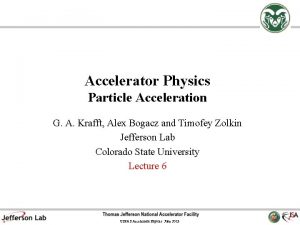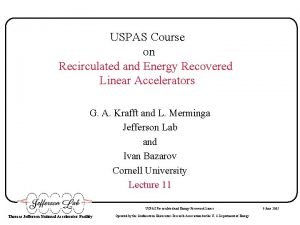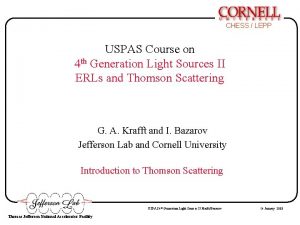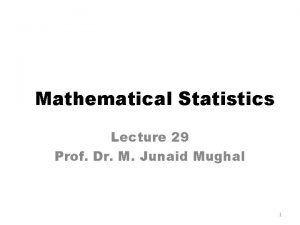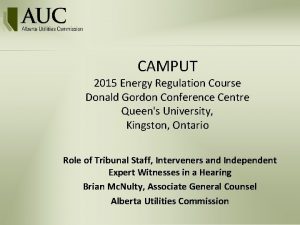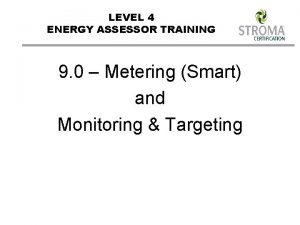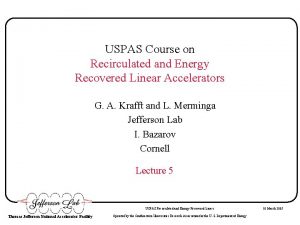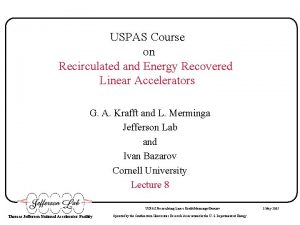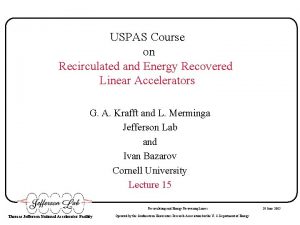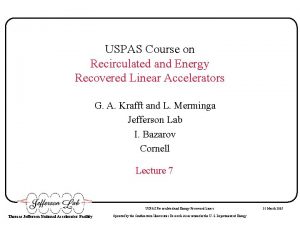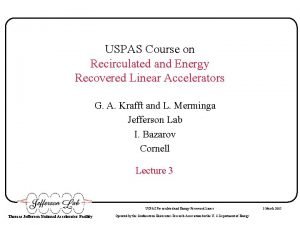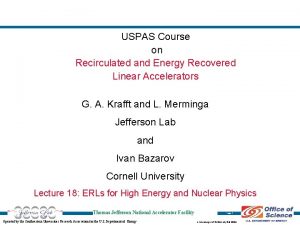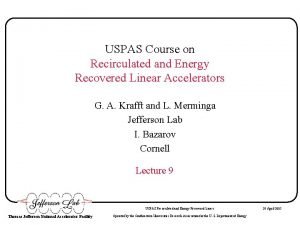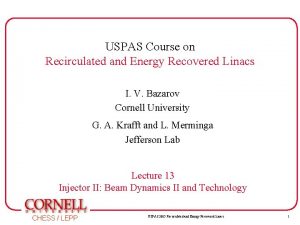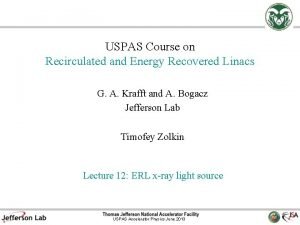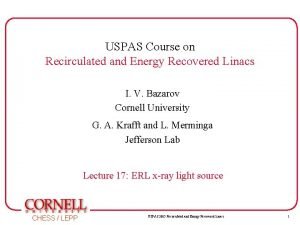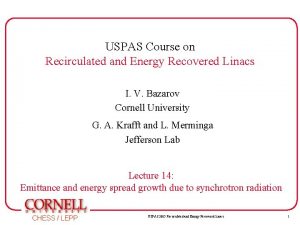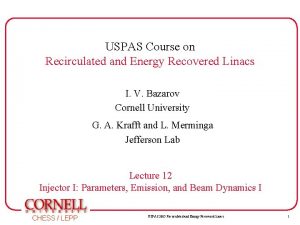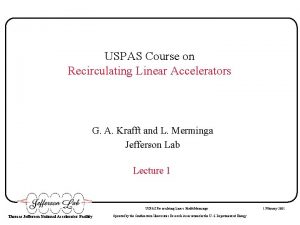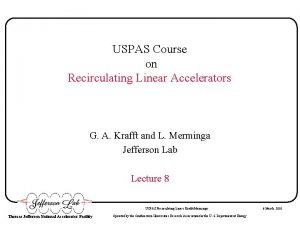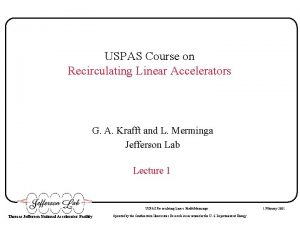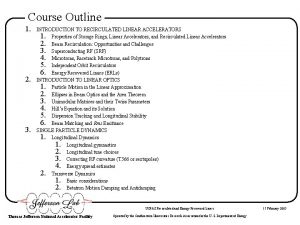USPAS Course on Recirculated and Energy Recovered Linear























- Slides: 23

USPAS Course on Recirculated and Energy Recovered Linear Accelerators G. A. Krafft and L. Merminga Jefferson Lab and Ivan Bazarov Cornell University Lecture 16 Thomas Jefferson National Accelerator Facility Operated by the Southeastern Universities Research Association for the U. S. Department of Energy Page 1 L. Merminga EPAC 04 July 5 -9 2004

ERL-Based Free Electron Lasers § Introduction § Operating ERL-FELs Jefferson Lab JAERI BINP § Planned ERL-FELs KAERI 4 GLS NHFML ARC-EN-CIEL § An Advanced ERL-FEL Concept TESLA XFEL-ERL § Summary Thomas Jefferson National Accelerator Facility Operated by the Southeastern Universities Research Association for the U. S. Department of Energy Page 2 L. Merminga EPAC 04 July 5 -9 2004

Free Electron Lasers § Free Electron Lasers (FELs) are sources of tunable, coherent radiation at wavelengths varying over a wide range from mm to IR to UV and VUV and to X-rays § An FEL consists of an electron accelerator and a wiggler magnet § Two FEL configurations: • Oscillator • Amplifier Thomas Jefferson National Accelerator Facility Operated by the Southeastern Universities Research Association for the U. S. Department of Energy Page 3 L. Merminga EPAC 04 July 5 -9 2004

FEL in Resonator Configuration Thomas Jefferson National Accelerator Facility Operated by the Southeastern Universities Research Association for the U. S. Department of Energy Page 4 L. Merminga EPAC 04 July 5 -9 2004

FEL in Amplifier Configuration Thomas Jefferson National Accelerator Facility Operated by the Southeastern Universities Research Association for the U. S. Department of Energy Page 5 L. Merminga EPAC 04 July 5 -9 2004

Electron Beam Requirements § FELs impose stringent requirements on the electron beam characteristics: • Energy is determined by the required wavelength via the resonance condition • Average current is determined by the required FEL output power, for a given wiggler design Thomas Jefferson National Accelerator Facility Operated by the Southeastern Universities Research Association for the U. S. Department of Energy Page 6 L. Merminga EPAC 04 July 5 -9 2004

Electron Beam Requirements (Cont’d) • • Bunch charge and bunch length are determined by the peak current required for sufficient gain Emittance and energy spread are determined by the FEL interaction: For optimum coupling, the optical beam must overlap the electron beam through the wiggler To ensure all electrons radiate within the bandwidth of the FEL Thomas Jefferson National Accelerator Facility Operated by the Southeastern Universities Research Association for the U. S. Department of Energy Page 7 L. Merminga EPAC 04 July 5 -9 2004

Operating ERL-FELs § Jefferson Lab FEL § JAERI FEL § BINP FEL Thomas Jefferson National Accelerator Facility Operated by the Southeastern Universities Research Association for the U. S. Department of Energy Page 8 L. Merminga EPAC 04 July 5 -9 2004

JLab 10 k. W IR FEL and 1 k. W UV FEL Output Light Parameters IR UV Wavelength range (microns) 1. 5 - 14 0. 25 - 1 Bunch Length (FWHM psec) 0. 2 - 2 Laser power / pulse 100 - 300 25 (micro. Joules) Laser power (k. W) >10 >1 Rep. Rate (cw operation, MHz) 4. 7 – 75 Electron Beam Parameters IR UV Energy (Me. V) Accelerator frequency (MHz) Charge per bunch (p. C) Average current (m. A) Peak Current (A) Beam Power (k. W) Energy Spread (%) Normalized emittance (mmmrad) Induced energy spread (full) 80 -200 1500 135 10 270 2000 0. 50 200 1500 135 5 270 1000 0. 13 <30 <11 10% 5% Thomas Jefferson National Accelerator Facility Operated by the Southeastern Universities Research Association for the U. S. Department of Energy Page 9 L. Merminga EPAC 04 July 5 -9 2004

JAERI ERL-FEL Output Light Parameters Wavelength range (microns) Bunch Length (FWHM psec) Laser power / pulse (micro. Joules) Laser power (k. W) Rep. Rate ( MHz) Macropulse format Achieved Goal 22 22 15 6 10 120 0. 1 10. 4 10 ms 10 83. 2 10 Hz CW Electron Beam Parameters Energy (Me. V) Accelerator frequency (MHz) Charge per bunch (p. C) Average current (m. A) Peak Current (A) Beam Power (k. W) Energy Spread (%) Normalized emittance (mm-mrad) Induced energy spread (full) Thomas Jefferson National Accelerator Facility Operated by the Southeastern Universities Research Association for the U. S. Department of Energy Page 10 L. Merminga EPAC 04 July 5 -9 2004 Achieved Goal 17 16. 4 500 500 5 40 33 83 85 656 ~0. 5 ~40 ~3%

BINP Recuperator FEL Output Light Parameters Wavelength range (microns) Bunch Length (FWHM psec) Laser power / pulse (micro. Joules) IR 120 -180 50 9 Laser power (k. W) 0. 2 Rep. Rate (cw operation, MHz) 22. 5 Electron Beam Parameters Energy (Me. V) Accelerator frequency (MHz) Charge per bunch (p. C) Average current (m. A) Peak Current (A) Beam Power (k. W) Energy Spread (%) Normalized emittance (mm-mrad) 180 MHz NC RF IR 12 180 900 20 10 240 0. 2 20 Thomas Jefferson National Accelerator Facility Operated by the Southeastern Universities Research Association for the U. S. Department of Energy Page 11 L. Merminga EPAC 04 July 5 -9 2004

BINP ERL-FEL Two ERLs (1 -orbit in vertical plane, 4 -orbits with the FEL bypass over the 2 nd orbit – in the horizontal plane) with one RF accelerating system Lasing (2) Lasing (4) Lasing (1) Thomas Jefferson National Accelerator Facility Operated by the Southeastern Universities Research Association for the U. S. Department of Energy Page 12 L. Merminga EPAC 04 July 5 -9 2004

Planned ERL-FELs § KAERI FEL § 4 GLS § NHMFL § ARC-EN-CIEL Thomas Jefferson National Accelerator Facility Operated by the Southeastern Universities Research Association for the U. S. Department of Energy Page 13 L. Merminga EPAC 04 July 5 -9 2004

KAERI FEL Output Light Parameters Wavelength range (microns) Bunch Length (FWHM psec) Laser power / pulse (m. Joules) Laser power (k. W) Rep. Rate ( MHz) Macropulse format Goal 3 -20 20 -50 50 -250 1 -5 22 CW Electron Beam Parameters Energy (Me. V) Accelerator frequency (MHz) Charge per bunch (p. C) Average current (m. A) Peak Current (A) Beam Power (k. W) Thomas Jefferson National Accelerator Facility Operated by the Southeastern Universities Research Association for the U. S. Department of Energy Page 14 L. Merminga EPAC 04 July 5 -9 2004 Goal 20 -40 352 500 10 10 -25 200 -400

Daresbury: ERL Prototype End arc Thomas Jefferson National Accelerator Facility Operated by the Southeastern Universities Research Association for the U. S. Department of Energy Page 15 L. Merminga EPAC 04 July 5 -9 2004

Daresbury: ERL Prototype Electron Beam Parameters Energy (Me. V) Accelerator frequency (MHz) Charge per bunch (p. C) Average current (m. A) Peak Current (A) Beam Power (k. W) Output Light Parameters Wavelength range (microns) Bunch Length (FWHM psec) Laser power / pulse (m. Joules) Laser power (k. W) Rep. Rate ( MHz) Macropulse format Thomas Jefferson National Accelerator Facility Operated by the Southeastern Universities Research Association for the U. S. Department of Energy Page 16 L. Merminga EPAC 04 July 5 -9 2004 Goal 30 -50 1300 >80 >0. 8 ~150 ~30 Goal 3 -75 0. 1 -few 90 0. 9 10 CW

Conceptual layout of 4 GLS Thomas Jefferson National Accelerator Facility Operated by the Southeastern Universities Research Association for the U. S. Department of Energy Page 17 L. Merminga EPAC 04 July 5 -9 2004

National High Magnetic Field Laboratory (NHMFL) Proposal for a Concept and Engineering Design submitted to NSF in January 2005, with UCSB and JLab as partners. The goal is to produce a facility that can combine high magnetic fields (~50 T) and intense electromagnetic radiation spanning the wavelength range of 2 mm to 2 mm. Electron Beam Parameters Energy (Me. V) Accelerator frequency (MHz) Charge per bunch (p. C) Average current (m. A) Peak Current (A) Beam Power (k. W) Goal 60 1500 135 5 200 300 Output Light Parameters Wavelength range (microns) Bunch Length (FWHM psec) Laser power / pulse (m. Joules) Laser power (k. W) Rep. Rate ( MHz) Macropulse format Thomas Jefferson National Accelerator Facility Operated by the Southeastern Universities Research Association for the U. S. Department of Energy Page 18 L. Merminga EPAC 04 July 5 -9 2004 Goal 2 -100 0. 5 -few ~25 ~1 37. 5 CW

ARC-EN-CIEL - SACLAY (ARC-EN-CIEL: Accelerator-Radiation Complex for ENhanced Coherent Intense Extended Light) Thomas Jefferson National Accelerator Facility Operated by the Southeastern Universities Research Association for the U. S. Department of Energy Page 19 L. Merminga EPAC 04 July 5 -9 2004

An Advanced ERL-FEL Concept TESLA XFEL ERL Thomas Jefferson National Accelerator Facility Operated by the Southeastern Universities Research Association for the U. S. Department of Energy Page 20 L. Merminga EPAC 04 July 5 -9 2004

TESLA XFEL ERL Performance Goals for SASE FEL Radiation at the DESY XFEL Photon energy 12. 4 – 0. 2 ke. V Photon wavelength 0. 1 – 6. 4 nm Peak power 24 – 135 GW Proposed ER operation would have a rep rate of 1 MHz instead of DESY XFEL rep rate of 10 Hz, increasing the average power and brilliance by a factor of 105 Average power 66 – 800 W # photons/ pulse 1 – 430 x 1012 Peak brilliance Average brilliance 5. 4 – 0. 6 x 1033 ** 1. 6 – 0. 3 x 1025 ** ** in units of photons / (s mrad 2 mm 2 0. 1% b. w. ) Thomas Jefferson National Accelerator Facility Operated by the Southeastern Universities Research Association for the U. S. Department of Energy Page 21 L. Merminga EPAC 04 July 5 -9 2004

How to avoid beam quality degradation due to beam interactions of the counter-propagating beams? At a 1 MHz rep rate there are 6 bunches in rep therate ERLthere at aare given time, At a 1 MHz 6 bunches thus separated in the 12 ERcollision Linac at locations a given time, thus 12 by 150 meters. collision locations separated by 150 The proposed solution is to avoid collisions altogether! Three suggested beam time structures: • Nominal beam: 1 pulse every s • Short trains of bunches: The bypass chicanes are about 4. 5 m in length. Bunch trains of this length (~20 RF cycles, 15 ns) can repeat every s without colliding. • Long trains: The return arc plus the straight section for undulators is about 2000 m long. A 6. 7 s train of bunches can repeat every 24 s without colliding. Thomas Jefferson National Accelerator Facility Operated by the Southeastern Universities Research Association for the U. S. Department of Energy Page 22 L. Merminga EPAC 04 July 5 -9 2004

Summary: A bright future § ERLs provide a powerful and elegant paradigm for high average power free electron lasers. § The pioneering ERL FELs have established the fundamental principles of ERLs. § The multitude of ERL-FEL projects and proposals worldwide promises an exciting next decade as: • • Three currently operating ERL-FELs will reach higher performance • New advanced concepts are being explored At least four more are in serious planning stages and will likely be constructed Many thanks to Todd Smith for providing much of the material. Thomas Jefferson National Accelerator Facility Operated by the Southeastern Universities Research Association for the U. S. Department of Energy Page 23 L. Merminga EPAC 04 July 5 -9 2004
 Uspas sport
Uspas sport Uspas
Uspas Uspas
Uspas Energy energy transfer and general energy analysis
Energy energy transfer and general energy analysis Energy energy transfer and general energy analysis
Energy energy transfer and general energy analysis Course number and title
Course number and title Management is responsible for unguarded moving parts
Management is responsible for unguarded moving parts Recovered memory 17
Recovered memory 17 Royalty in trading account
Royalty in trading account Dr junaid mughal
Dr junaid mughal Building with bricks
Building with bricks Course interne moyenne externe
Course interne moyenne externe Simple linear regression and multiple regression
Simple linear regression and multiple regression Linear texts examples
Linear texts examples Non linear plots
Non linear plots Linear pipeline processor
Linear pipeline processor Disadvantages of multimedia
Disadvantages of multimedia Linear impulse
Linear impulse Persamaan simultan
Persamaan simultan Convert right linear grammar to left
Convert right linear grammar to left Difference between linear and non linear equation
Difference between linear and non linear equation Persamaan linear simultan
Persamaan linear simultan Camput energy regulation course
Camput energy regulation course Domestic energy assessor course near me
Domestic energy assessor course near me
